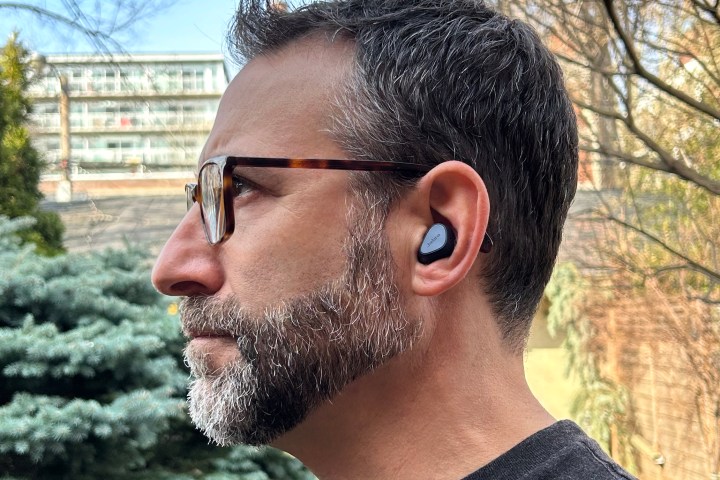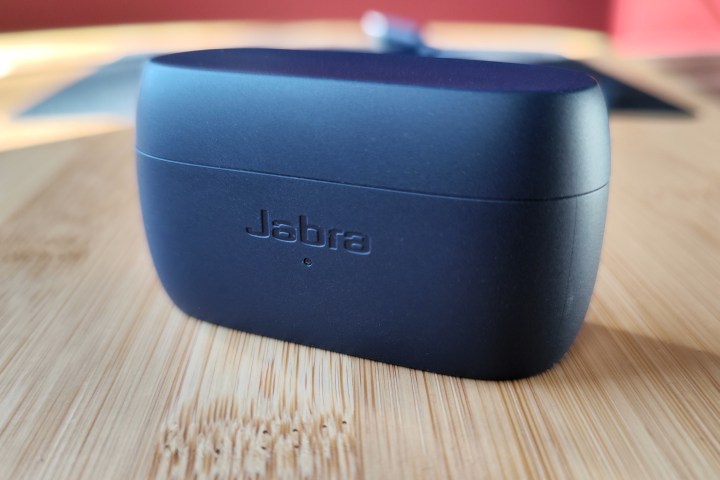
- Comfy and secure
- Water and dust resistant
- Very good sound quality
- Effective noise canceling
- Excellent transparency mode
- Bluetooth Multipoint
- No wireless charging
- No AAC Bluetooth codec
- No wear sensors
- Middling battery life
While certainly there are wireless earbuds that continue to push the boundaries in areas like sound quality, noise cancellation, spatial audio, and advanced sensors for activity tracking, most of us just need a reliable, comfortable, decent-sounding set that won’t make us rethink our annual tech budgets.
Priced at $100, Jabra’s latest earbuds, the Elite 4, fit that need perfectly. Here’s why.
That Jabra shape

With only a few small exceptions, all of Jabra’s wireless earbuds have the same basic shape. It’s a shape I have always found to be comfortable, and that goes for the Elite 4 too. They won’t work for everyone — my daughter has never been able to wear Jabras — but if you’ve never had any particular fit problems with other earbuds, I suspect you’ll find the Elite 4 both comfy and secure.
The other feature that Jabra has maintained across all of its products is physical buttons instead of touch controls. And after testing what must be well over 200 wireless earbuds at this point, I still think buttons trump touch. The Elite 4’s controls are a textbook example of why: they’re easy to locate, you can use them even while wearing gloves, they give a precise and tactile click when you press them, and they take just the right amount of pressure — accidental clicks are unlikely and you won’t feel like you’re trying to push them into your skull.

Unfortunately, there’s no way to customize the controls’ behavior as you can on more expensive Jabra models like the Elite 5, 7 Active, and 7 Pro. But once you memorize what each click pattern does, it becomes second nature — most of the default patterns are very intuitive.
The Elite 4 also boast a decent amount of protection from water and dust with an IP55 rating — more than enough for sweaty workouts. Need even more water protection? Spend the extra $20 and get the essentially waterproof Elite 4 Active.
Perfectly balanced active noise cancellation
If you’re wondering why you should pay $20 more to jump from the $80 Elite 3 to the Elite 4, it’s this: active noise cancellation (ANC). The Elite 4 are Jabra’s least expensive earbuds to offer this popular feature and the company didn’t cheap out. It may not be able to compete with the likes of the AirPods Pro 2 or the Bose Quiet Comfort Earbuds II, but it takes the Elite 4’s already good noise isolation and noticeably decreases the number of external sounds that make it through to your ears.
Want help focusing on work while in a noisy office or a coffee shop? They can do that. Want to be able to hear your podcasts clearly as you walk down busy urban sidewalks dotted with construction sites? They can do that too. Jabra lets you personalize the amount of ANC in the Sound+ app, but I didn’t find the adjustments made much of a difference — it was great right out of the box.
With a single click of the left earbud button, you can switch to an excellent transparency mode that lets all of that sound in so you can keep tabs on what’s going on around you.
Still sound great

Are the Elite 4 going to impress audiophiles with their sound quality? Nope, but they are absolutely fine for music listening that takes place while you’re going about your day. iPhone users will have to content themselves with basic Bluetooth — the Elite 4 only support the SBC Bluetooth codec, not the higher-quality AAC codec — but Android users get aptX, which can outperform both SBC and AAC in terms of fidelity.
Regardless of the codecs in use, there’s very good clarity, with excellent frequency balance out of the box, and Jabra offers some nice EQ tweaks within its free Sound+ companion app.
There’s plenty of bass for those who like their music with some low-end kick and the soundstage, while not massive, is wide enough and precise enough to let you enjoy plenty of detail from your favorite tracks.
Multitasking with multipoint

Jabra has given the Elite 4 some helpful Bluetooth bonuses, like Google Fast Pair and Microsoft Swift Pair, which speed the initial connection process on Android and Windows devices. I’ve never found initial Bluetooth pairing to be very troublesome even without these technologies, so I’m inclined to say they’re nice-to-haves.
But if we’re talking about need-to-haves, let’s give Jabra props for adding Bluetooth Multipoint so you can keep the Elite 4 connected to two of your devices simultaneously. If you want to use your earbuds on your phone and your laptop (which is most of us these days), it’s not just a convenience, it’s a necessity. A necessity you won’t find on the Elite 3 or the Elite 4 Active, which makes the Elite 4 the least expensive Jabra buds to offer it (previously that title went to the Elite 5).
Using Multipoint to connect the Elite 4 to an iPhone and an Android handset simultaneously worked without a hitch — as did connecting them to a MacBook Air and an Android device. For some reason though, connecting to the iPhone and the MacBook Air was a bit troublesome. In some instances, the second device connected would produce a broken-up and garbled audio stream. Sometimes the interference lasted a few seconds, sometimes it lasted longer.
I’m guessing Jabra will be able to fix this with a firmware update — the company is really good about issuing updates long after you buy their product — but in the meantime, be prepared for a bit of weirdness when combining some devices.
Here for a good time, not a long time

When buying wireless earbuds for $100, you can’t expect the world. The Elite 4 lack some niceties like wireless charging, multiple voice assistants, and wear sensors to auto-pause and resume your music. I’m fine with these omissions for the price.
I’m a little less understanding when it comes to battery life. At a stated 5.5 hours of playtime per charge and 22 hours total with the case for ANC listening, the Elite 4 seem a bit outgunned. Those numbers become more useful when you turn ANC off (7/28 respectively), but it’s hard not to notice that competitors at the same price, like the Soundcore Space A40, can last a lot longer at 8/40 — and that’s with ANC on. Even the less expensive, $80 Earfun Air Pro 3 can swing 7/37 with ANC on, so really, what’s Jabra’s excuse? Oh and just to put some salt in the wound, both of these models have wireless charging too. Ouch.
Clear calls

Call quality is one of Jabra’s strong suits and the Elite don’t disappoint. In all but the noisiest conditions, your callers will hear you clearly, with virtually no compression or wobbliness. Sadly, the sidetone feature (designed to let you hear your own voice clearly while on a call) is a lot less effective.
In some ways, this isn’t all that surprising. The Elite 5 and Elite 7 Pro, both of which excel at side tone, have up to eight mics to work with. The Elite 4, by contrast, have just four, and I guess something has to give.
It’s not a deal-breaker by any means, but it’s worth mentioning that if you do a lot of calling, consider the Elite 5 instead.
Another handy feature you won’t find on many wireless earbuds is mic muting during calls.
Jabra fans already know that the brand builds robust wireless earbuds that sound great for their price. The Elite 4 might not include every single feature that similarly-priced competitors offer, but if you’re looking for a set of buds you can use for everything from work to play to workouts and daily commutes without spending serious cash, they’re absolutely worth it.






